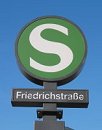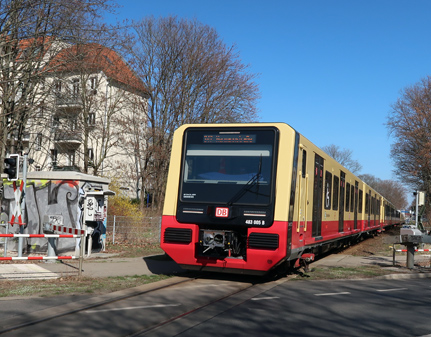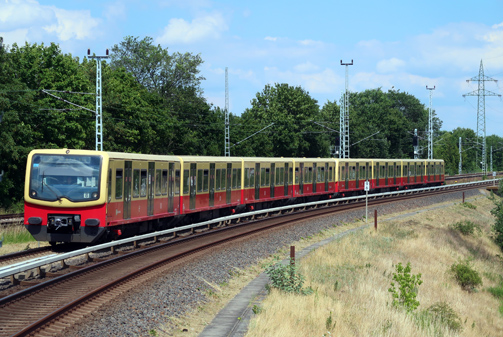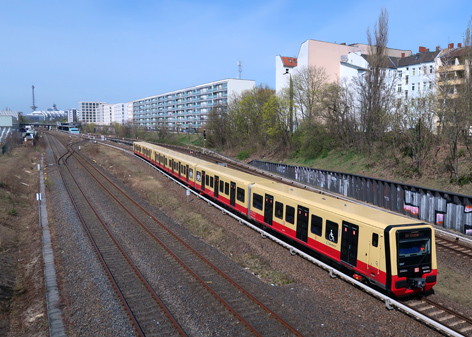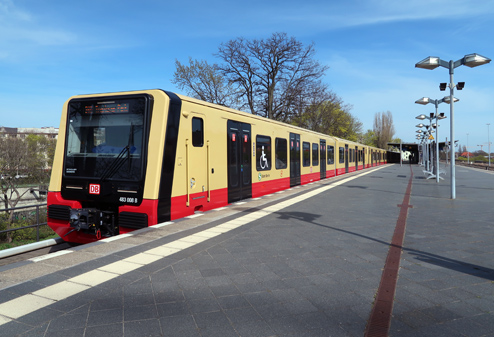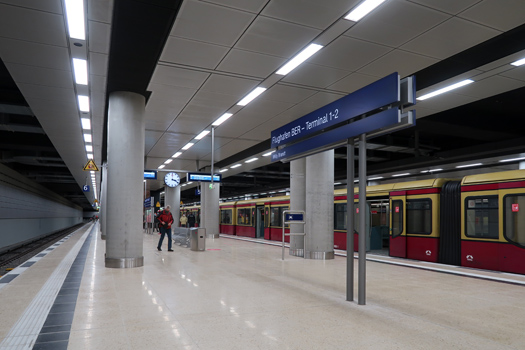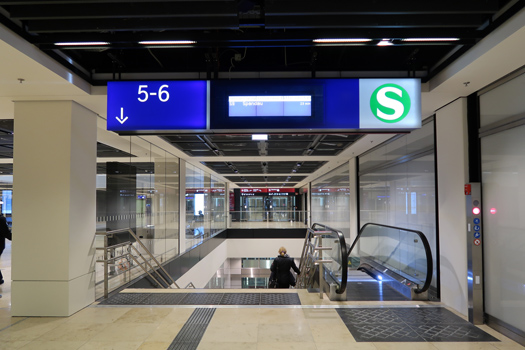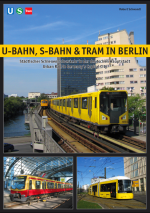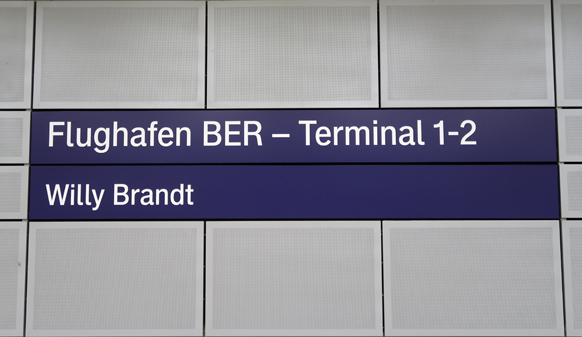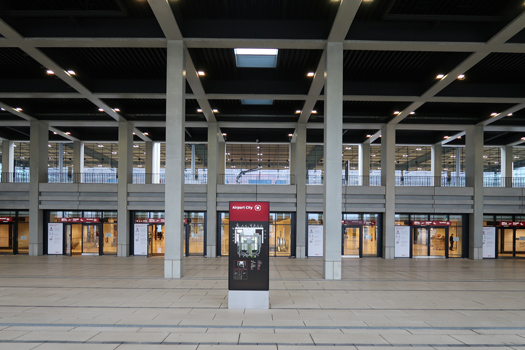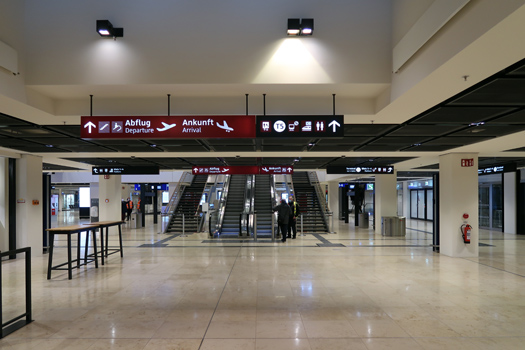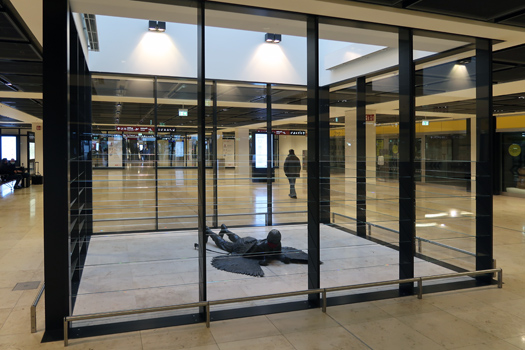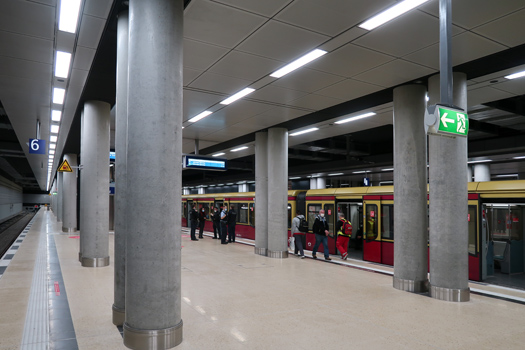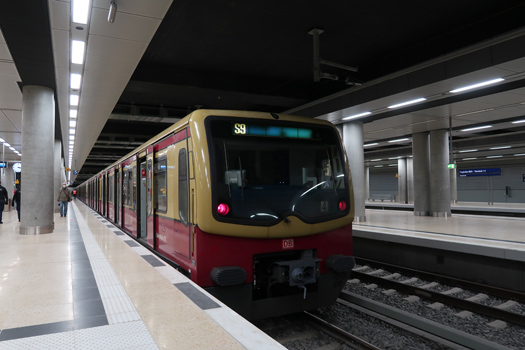|
[ UrbanRail.Net ] [ Europe ] [ Americas ] [ Asia ] [ Africa ] [ Oceania ] [ News ] [ Books ] [ Links ] |
| Berlin . Germany |
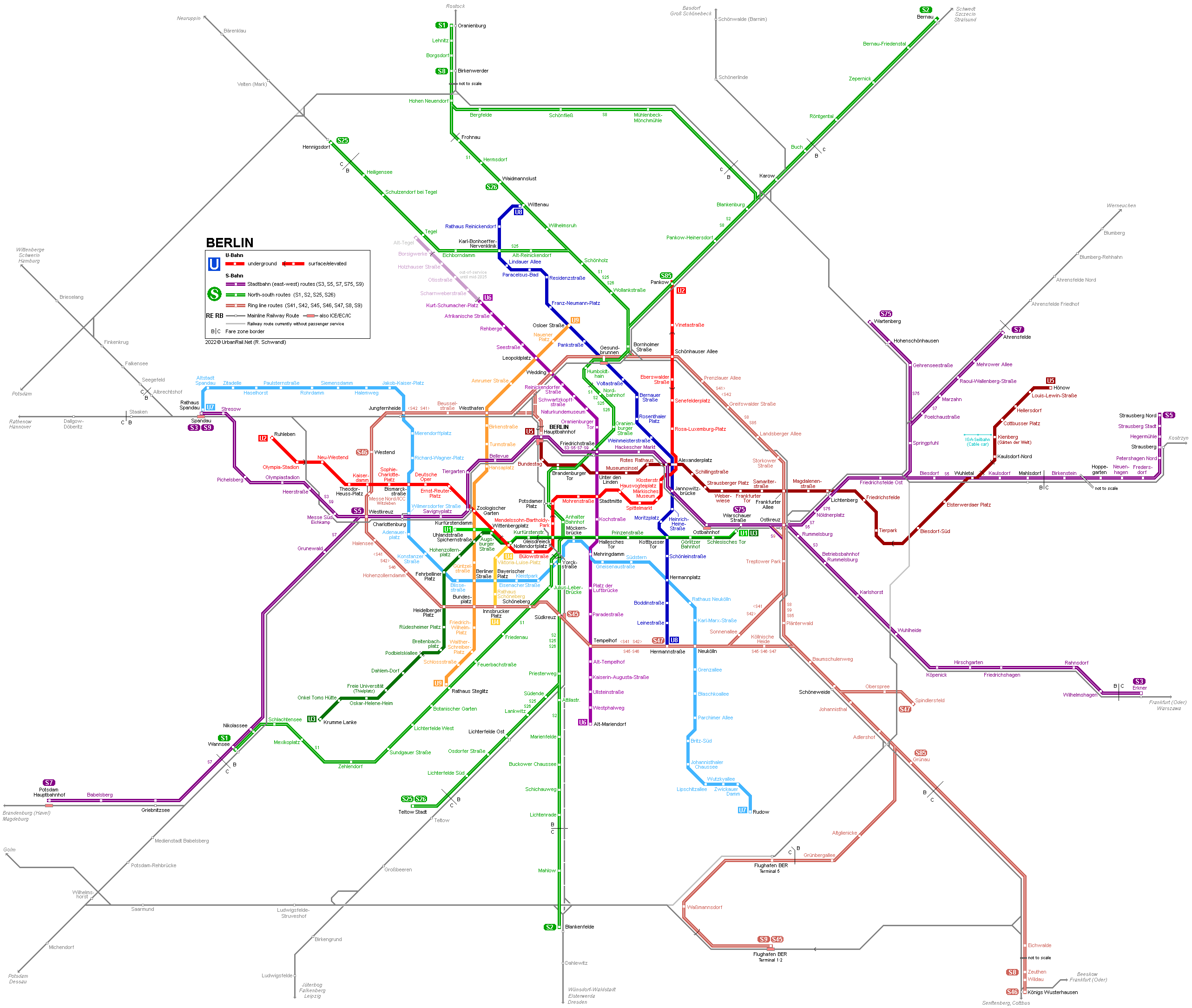
|
U-Bahn | Tram | Tickets & Fares | Books | Links |
|
| S-Bahn System | |
|
The Berlin
S-Bahn may be considered a metro in its own right for the following
reasons: The network can be classified into three groups of lines (as of 14 Dec 2025): 1- Stadtbahn lines serving the east-west route through the city centre, all on the surface, in the city centre mainly on a brick viaduct: -
S3: Spandau — Erkner 2- Nordsüdbahn lines operating north-south through the city tunnel: -
S1: Oranienburg — Wannsee 3- Ringbahn lines running on the circular route and the southeastern branch (Görlitzer Bahn), all on the surface except at the airport: -
S41: ring line clockwise Most sections outside the ring line but within the Berlin city boundaries are served every ten minutes, whereas some sections outside Berlin in Brandenburg have a train every 20 minutes. Besides S-Bahn lines S9 and S85 and several RE and RB lines, the airport is served every 15 minutes by the FEX (Berlin Hbf — Südkreuz — Flughafen BER).
|
|
|
|
|
| S-Bahn History | |
|
- In the middle of the 19th century, many radial railway lines were built from various termini around the current city centre. Along most of these lines a separate pair of tracks for suburban traffic was added around the turn of the century. The ring line was opened during the 1870's, followed by the Stadtbahn, which was inaugurated in 1882. At the time the U-Bahn began operating in 1902, tests for electric traction were also carried out on the suburban railway lines. The line from the former Potsdamer Bahnhof to Lichterfelde Ost was the first regular electric suburban service, while the other lines kept using steam locomotives until the 1920's. In 1924, today's system (800 V dc, third rail) was introduced on the line from Stettiner Bahnhof (now Nordbahnhof) to Bernau. Soon the other two northern lines (to Oranienburg and to Hennigsdorf / Velten) followed. The positive experience opened the doors for the 'Great Electrification' of the entire suburban network, which since 1 Dec 1930 has been called the 'S-Bahn', the 'S' referring both to Stadt [city] and schnell [fast].
|
|
|
|
|
- While all suburban lines were converted from steam to electric traction, a north-south tunnel was built to link the northern and the southern lines. The first section from Stettiner Bahnhof to Unter den Linden opened in 1936 just before the Olympic Games. The remaining part followed in 1939, just after the outbreak of World War II. During the War, many routes and station buildings were damaged and it took several years until the whole network was in service again. - Until 1961, S-Bahn trains kept running from East Berlin to West Berlin and back, but when the Wall was built, the network was cut in two, although both systems were operated by the East German Reichsbahn as long as 1984. The erection of the Wall resulted in an S-Bahn boycott in West Berlin, and S-Bahn installations deteriorated through the years. After a railway workers' strike in 1980, many western lines were closed down. In East Berlin, however, the S-Bahn became the backbone of the urban transport system and new extensions were built from Grünau to Königs Wusterhausen (1951), to Strausberg Nord (1956), to Schönefeld Airport (1961), to Ahrensfelde (1976-82) and to Wartenberg (1984/85). -
After the city's reunification in 1990, a lot of effort was put
in restoring the former S-Bahn network to its 1961 status, especially
the ring line. In December 1997 the connection between Neukölln
and Treptower Park via Sonnenallee reopened, which allowed
S4 trains to run 75% of the whole ring (between Schönhauser
Allee and Jungfernheide). On 19 Dec. 1999, two more stations
were put into service, Beusselstraße and Westhafen.
From 16 Sept. 2001, trains also ran from Schönhauser Allee
to Gesundbrunnen (S4). Finally, on 16 June 2002, the section
Gesundbrunnen - Westhafen also reopened; ever since, trains operating
the full circle are labelled S41 (clockwise) or S42 (anticlockwise).
Several other lines share some section of the ring route. -
To serve the new BER Airport, the Schönefeld branch was
extended by 8 km from its former terminus (now Flughafen BER Terminal
5) to a new underground station below Terminals 1-2. Together with
the new airport, this extension was scheduled to open in June 2012,
but due to the airport's delayed opening, the S-Bahn only started to
serve the new section 8 years later: |
|
| <<< Up | U-Bahn | Tram | Tickets & Fares | Books | Links | |
|
Projects |
|
|
During the reconstruction of the northern section of the ring line, provisions were made between Westhafen and Wedding for a branch towards the central station, with a possible second north-south tunnel in the future. The project is generally referred to as 'S21' or 'Citybahn'. Construction of the northern section began in mid-2011. Initially, when opening in spring 2026, only 4-car shuttle trains (S15) will operate between Gesundbrunnen and Hauptbahnhof, using a temporary station built inside the running tunnel to the north of the railway station. Construction of the link to Potsdamer Platz has not started yet. An extension from Spandau to Falkensee has repeately been proposed, and a short version on Berlin territory only may be built in an initial stage. In conjunction with an urban development project promoted by Siemens, the old 'Siemensbahn', a branch out of service since 1980, may be reactivated. Diverging from the ring line at Jungfernheide, it used to serve stations at Wernerwerke, Siemensstadt (near U7 Rohrdamm) and Gartenfeld. A mostly underground extension of this branch to serve the northern parts of Spandau (Wasserstadt) is being examined. |
|
| Links | |
|
S-Bahn Berlin (Official Site) VBB (Fare system Berlin-Brandenburg) Stadtschnellbahn Berlin - Geschichte und Geschichten rund um die Berliner S-Bahn (most extensive private website about the S-Bahn) S-Bahn Museum (at S-Bahn station Griebnitzsee - S7) Geschichte des Berliner Nahverkehrs Last edition of East Berlin's S & U-Bahn-Network 1990 from my collection (109K) Stadtentwicklung Berlin - Verkehr BVG Online-Timetable or DB-Timetable (from door to door in Germany) |
|
|
<<< Up | U-Bahn | Tram | Tickets & Fares | Books | Links
|
|
| Books | |
|
Klaus Kurpjuweit, Bodo Schulz: Album Berliner Verkehr 1989/1990. - Nov. 2004, Neddermeyer; Berlin, ISBN 3933254469 Wolf-Dietger Machel: Berliner Schienennahverkehr. - Aug. 2004, 160 p. - Bruckmann, ISBN: 3765471348 Wolfgang Kiebert: Die Berliner S-Bahn 1924 bis heute. - 07/2004, 160 p., Transpress, ISBN: 3613712423 Manuel Jacob: Der elektrische Betrieb auf der Berliner S-Bahn, Bd 6: Das Netz wächst zusammen - 1980 - 2004. - 01/2004, 240 S. Neddermeyer, ISBN 393325423X Wolfgang K mmerer: 100 Jahre elektrischer Betrieb Berlin Potsdamer Bahnhof - Gro Lichterfelde Ost. - Okt. 2003, 96 S., Neddermeyer, ISBN 3933254396 Robert Schwandl: BERLIN S-BAHN ALBUM. - All 170 S-Bahn in Colour. - 144 p., 400 colour photos, maps, German/English; April 2003, Berlin, ISBN 3-936573-02-6 More info Larissa Sabottka: Die eisernen Br cken der Berliner S- Bahn. Bestandsdokumentation und Bestandsanalyse. - 04/2003, Mann (Gebr.), Berlin, ISBN 3786124639 Susanne Dost: Richard Brademann (1884-1965) - Architekt der Berliner S-Bahn. - 2002, 232p., Neddermeyer ISBN 3933254361 Michael Bienert, Ralph Hoppe: Eine Stunde Stadt. Berliner Ringbahn- Reise. - 2002, 320p - Berlin Edition, ISBN 3814800966 Konrad Koschinski: Der elektrische Betrieb auf der Berliner S-Bahn, Bd 5: Auf Zeit getrennt - 1960 bis 1980. - 2002, Neddermeyer, ISBN 3-254933-22-1 Bernd Neddermeyer: Der elektrische Betrieb auf der Berliner S-Bahn, Bd.1, Dampf oder Elektrizit t?. - 1999, Neddermeyer, ISBN 3933254051 Bernhard Strowitzki: S-Bahn Berlin. Geschichte(n) für unterwegs. - 288p., b/w, GVE Verlag, Berlin, April 2002, ISBN 3892180733 Hardy, Brian: THE BERLIN S-BAHN. Capital Transport, 1996. - Well illustrated handbook. J rgen Meyer-Kronthaler, Wolfgang Kramer: Berlins S- Bahnh fe. Ein dreiviertel Jahrhundert. - 373 p. - bebra Verlag, Berlin, 1998, ISBN 393086360X G nther Bellmann: Durch Berlin mit der S- Bahn. Savignyplatz bis Alexanderplatz. 2001, bebra, Berlin. Behrens, A. und V. Noth: BERLINER STADTBAHN.- Bilder und Geschichten. - Ullstein, 1995. - Great colourful volume showing lots of artistic S-Bahn impressions. Die Stadtbahn. Ein Viadukt mitten durch Berlin - GVE e.V.,1998, ISBN 3892180466 Andreas Butter, Hans-Joachim Kirsche, Erich Preu : BERLIN OSTKREUZ. Die Drehscheibe des S- Bahn- Verkehrs. - 2000, 159 p., GeraNova, ISBN 393278524X Carl W. Schmiedeke: Der Wagenpark der Berliner S-Bahn. - Lokrundschau, ISBN 3931647056 Nord-S d-Bahn. Vom Geistertunnel zur City-S-Bahn. Die Flutung des Berliner S-Bahn-Tunnels in den letzten Kriegstagen. - 1999, 120p., GVE e. V., ISBN 3892180598 Berliner
S-Bahn. 70 Jahre Hauptwerkstatt Sch neweide. - 1997,
96p., GVE e. V., ISBN 3892180512
|
|
|
|
|
2004
© UrbanRail.Net by Robert
Schwandl.
